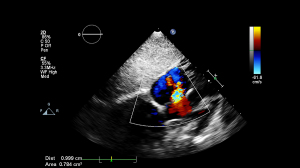GE HealthCare, NVIDIA streamline ultrasound segmentation through deep learning partnership
by
John R. Fischer, Senior Reporter | March 20, 2024

GE HealthCare and NVIDIA are integrating their AI technologies and software to streamline ultrasound segmentation.
GE HealthCare is streamlining ultrasound segmentation, an often laborious job, with a new research model SonoSamTrack, which completes this task faster and without loss of accuracy through a combination of a foundational AI model and NVIDIA’s TensorRT software development kit.
Foundational models learn patterns from unlabeled data sets and computational resources that not only provide insights into specific patient populations but act as a basis when coming across new findings, allowing them to adapt to tasks and care regimens quickly, with fewer labeled examples. The one used for SonoSamTrack is called SonoSam and eliminates the need to manually label and input large data sets into it. A simplified and streamlined version called SonoSAMLite is also available.
TensorRT is a high-performance deep learning inference library for optimizing and deploying neural network models for highly productive tasks on NVIDIA’s accelerated computing platforms. The technology performs up to 36 times faster than CPU-only platforms during inference, meaning that it speeds up image segmentation while maintaining accuracy.
In being able to teach itself, SonoSamTrack can use TensorRT to make predictions based on data it has never encountered before regarding ultrasound segmentation as well as other tasks.
“Combining NVIDIA’s accelerated computing and AI technology stack with GE HealthCare’s medical imaging expertise will help enhance patient care by making ultrasound diagnostics quicker and more accurate,” said David Niewolny, director of business development for healthcare and medical at NVIDIA. “This collaboration underscores the importance of using AI for lifesaving advancements and setting new standards in healthcare.”
In a study, GE HealthCare’s SonoSAMTrack was highly accurate in segmenting information in seven ultrasound data sets, which included a wide range of anatomies such as the adult heart and fetal head, and pathologies such as breast lesions and musculoskeletal pathologies. It also did the same across different scanning devices.
The technology outperformed competing methods substantially, and using the TensorRT software development kit, it enhanced speed and efficiency, reducing the number of clicks to a range of 2-6 for precise segmentation, thereby minimizing user input.
TensorRT optimizes neural network models using distillation and quantization techniques. Distillation involves using a larger model to train a smaller, simpler model and transferring information in compressed form so the smaller one performs just as efficiently as the bigger model. Quantization reduces the precision (number of bits) that represent model parameters and activations, reducing memory bandwidth requirements and computational complexity without sacrificing accuracy. This leads to faster inference and less power consumption.
The integration of these technologies is based on a prior collaboration formed in 2017 between GE HealthCare and NVIDIA around AI.
“By utilizing these versatile, generalist models, we aim to adapt more efficiently to new tasks and medical imaging modalities, often requiring far less labeled data compared to the traditional model retraining approach,” said Parminder Bhatia, chief AI officer of GE HealthCare.
|
|
|
You Must Be Logged In To Post A Comment
|
